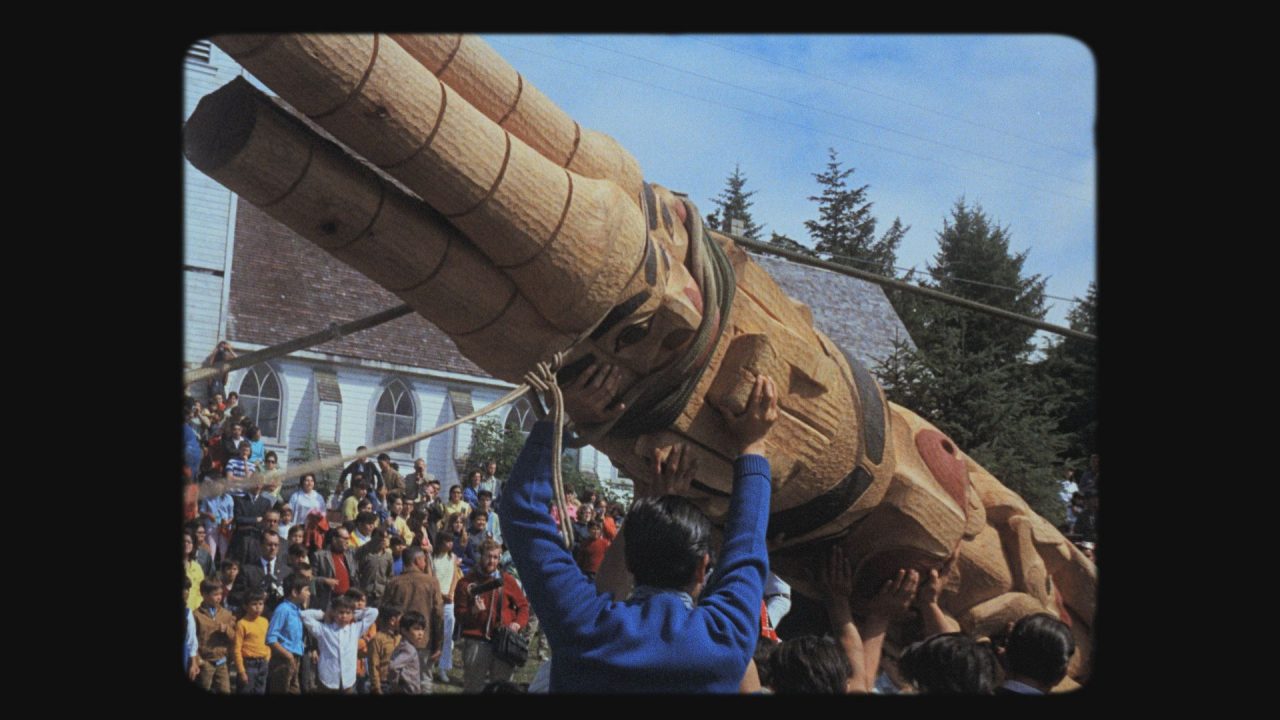
Mini-Lesson for Now Is the Time
Mini-Lesson for Now Is the Time
Mini-Lesson for Now Is the Time
School Subjects:
- Indigenous Studies – History/Politics
- Identity/Society
- Social Studies – Contemporary Issues
Ages: 12-14
Warning: Swearing (e.g., “Holy s***” )
Now Is the Time, Christopher Auchter, provided by the National Film Board of Canada
Keywords/Topics: Cultural Identity, Haida, Massett, Cultural Revitalization, Indigenous Peoples, Indigenous Art, Community, Resilience, Carving, British Columbia
Guiding Question: What are the connections between Indigenous art and cultural identity? How does Indigenous art contribute to shaping community?
Educational Synopsis: Now Is the Time is about Haida artist and carver Robert Davidson’s first totem pole raising in Massett, B.C., in 1969. It explores an act of cultural revitalization and how it impacted a community, and features Haida voices telling a Haida story. Haida director Christopher Auchter’s film shares reflections from Robert and the community on this momentous event—the first new pole that had been raised on Haida Gwaii in almost a century.
At 4:10, Robert expresses his feelings at seeing the log he will carve. Never having worked on such a scale before, he uses the phrase “Holy shit!”
Some knowledge about the Potlatch Ban, Indian residential schools and colonization would be useful for the discussions in the activities. Discussions are focused on revitalization and resiliency of the community.
You can extend your learning by locating the film and its perspective. This can take the form of learning more about Haida Gwaii, the Haida Nation or Robert Davidson’s work. Robert recently partnered with his daughter Sara Davidson to publish a book entitled Potlatch as Pedagogy: Learning through Ceremony.
Activity 1) Think. Pair. Share.
Clip #1 (3 min 8 s)
Have students pair up and take turns sharing their responses to the following questions:
Imagine a world without art: What would it look like? How would it feel? How does this impact the community?
Go Deeper
Watch with these questions in mind:
- What were the strategies Robert used to gather knowledge?
- Who helped Robert, and how did they help him?
- What impact did this have on the community?
- How does this connect with the theme of cultural revitalization and the title of the film, Now Is the Time?
Activity 2) Classroom Activity: 4 Quadrants
Clip #2 (5 min 5 s)
Robert was given the opportunity to raise the pole with a crane, but the community decided not to, preferring to raise the pole the “old way.” Why is this significant? Think about the engineering aspects of raising the pole without a crane and what that involves in terms of community, co-operation and tradition.
Fold a piece of paper into four squares. In the first two squares, sketch or describe the process of raising the pole the “old way.”
In the third square, list feelings, practices and strengths that came back to the community the day the pole was raised.
In the last square, have students reflect on their own feelings or thoughts after watching the film.
Go Deeper
In groups of two to four, discuss these quotes using the following questions. Focus on the feelings of the community up to the moment when the pole is raised.
- What are the connections between Indigenous art and cultural identity?
- How does Indigenous art contribute to shaping community?
- How is knowledge/culture passed on?
9:24–9:46: Robert Davidson: “I didn’t realize how much ceremony was connected to the art until that moment. My grandparents and their generation coming together and they all told stories, and from those stories that became the recipe for the pole raising.”
8:50: Tsinii to Robert as they begin to move the pole: “Robert, that totem pole doesn’t belong to you anymore, it belongs to them.”
Activity 3) – Quiet Writing Reflection
Clip #3 (3 min 9 s)
Reflect on and respond to these questions: What is cultural revitalization? How can cultural revitalization impact community and cultural identity?
Use these quotes and clips to help guide your thinking:
4:58–5:15: Robert’s feelings on finding an old storage box in the community: “I was so taken by it, having this one object that survived this whole dark period.”
7:00–7:23: Robert: “I like to equate our spirit as being too strong to die—that’s why we’re still here.”
Go Deeper
The cultural practice of carving poles and potlatch was taken away from the people—not lost!—and members of the community were resilient and able to hold onto the knowledge until a time when it wasn’t against the law to practise it again.
- Research the Potlatch Ban and discuss as a class how the missionaries impacted the community.
- Why is knowing the history important in telling the story of cultural revitalization?
- How does this connect to the phrase “imagine a world without art”?
- How were people able to hold onto their culture?
7:30–7:58: Robert: “There was a couple of people say, ‘Why you want to bring those old things back?’ That really just came from the pain that they went through.”
7:58: Robert: “I mean, I cried when I heard that. But it didn’t stop us.”
0:43–0:58: Robert sets the context for what the village was like before 1964 after asking an Elder, “Were there any totem poles raised in the villages in her lifetime? And she said ‘No,’ and she was born [in] 1895.”
1:26–2:17: Elder Joe Weir recounts the instructions from the missionaries and what happened to the poles in the village: “The missionaries say if they don’t get rid of these poles, you’ll never get into heaven.”
Extension Activity
Watch Eugene Boyko’s 1970 NFB film This Was the Time, and ask students what director Christopher Auchter has achieved by remixing this film and deconstructing its colonial vision.
Noelle Pepin is the Indigenous Education Resource Teacher who works to implement culturally responsive curriculum and learning experience in accordance with the Indigenous Education mandate and Local Education Agreements. She works throughout School District 57 in Prince George, British Columbia, in direct collaboration with district staff, educational partners and Indigenous rights holders to ensure authentic infusion of Indigenous content and pedagogies in curriculum, assessments, teaching and learning resources/materials and learning environments. She is a seasoned presenter and content writer for the NFB’s Educator Network.
Pour lire cet article en français, cliquez ici.
Discover more Mini-Lessons | Watch educational films on NFB Education | Watch educational playlists on NFB Education | Follow NFB Education on Facebook | Follow NFB Education on Pinterest | Subscribe to the NFB Education Newsletter



